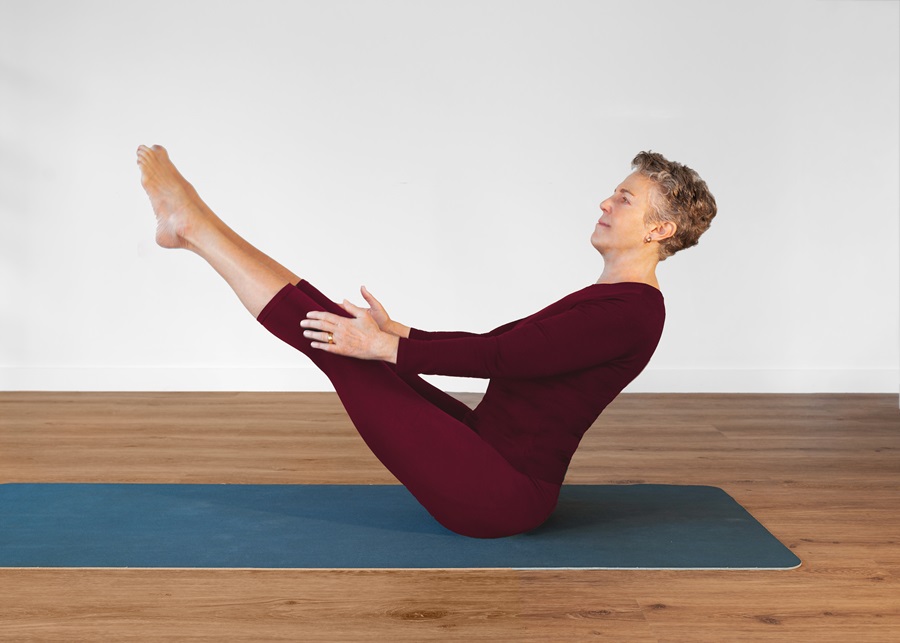In setting my intentions for the new year, I have been anticipating the need for strength, endurance, and courage. One vision that keeps coming to mind is the need to build an extra strong vessel in which to ride the rough waves emanating from the inauguration of the era ahead.
Paripurna Navasana, Boat Pose, is just the pose for that. The shape looks like a boat with the arms as the gunwales. The word Navasana combines the Sanskrit words for boat, nava, and seat, or seated posture, asana. Paripurna translates as complete or full, and adding it to the name of this pose brings to mind the image of building a seaworthy boat. This pose dispels my worries and instead engenders a feeling of empowerment. I hope it will do that for you, too.
Boat Pose is a seated balance pose that strengthens your legs, tones the abdominal and pelvic muscles, stimulates digestion and circulation, and develops concentration, confidence, and overall strength. It is not recommended if you have a recent or chronic back or neck injury or if you are pregnant. I’ll offer some ways to support yourself in the pose so you can begin to practice it safely — but they don’t change my advice about finding other empowering poses to adapt (Warrior Pose, for instance) instead of this one if you are pregnant.
Warm up your core before going into this pose. To start, sit on the floor on a mat or blanket. Then lie on your back with your knees bent and place your feet on the mat about shoulder width apart. Lift your lower abdomen slightly, imagining that you are gently lifting your inner organs in and up toward your ribs. Now tuck the lower ribs in slightly and see if this gives you a sense of engaging your core abdominal muscles. Maintain that engagement, roll to one side, and use your hands and arms to push yourself up to a sitting position.

To move into the pose, bend your knees and place your feet on the mat in front of you. Place your hands on the backs of your thighs and hold on firmly as you draw yourself up, lengthening your spine as you draw your sacrum — which supports your spine at its very base — down, still keeping the core engaged.
Now lean back, releasing your hands from your thighs and stretching your arms out at your sides. This may feel like quite enough summoning of your strength and energy. If so, this is your boat pose.
To take the pose further, feel your sitting bones making contact with the floor, and if you’re stable, try lifting one foot off the ground; extend the leg and balance here. If this feels stable, then try lifting the other leg alongside the first. If this makes you wobble or hurts your back or neck, just work toward the pose one leg at a time.
If you are secure with both legs lifted, straighten them so that your legs and torso make a V shape. You will be balanced on your sitting bones with your thighs at a 45-degree angle to the floor. Keep your arms lifted alongside your body. Now see if you can straighten your legs, extending them only as far as you can while maintaining your balance. Your core muscles will be working hard here as you breathe and balance. Concentrate on extending and expanding your boat shape. Breathe as you hold the pose, taking from one to four good breaths, then begin coming out of the pose by lowering your feet to the floor.
Some other supportive options are to lean back on your forearms, palms on the floor, then lift your legs. Or keep your arms extended behind you, hands on the floor for support. Working with either of these options and beginning with one leg at a time will help you build strength.
It is worth considering that the ancient yogis developed the asanas as a way to prepare the body for a long period of meditation. This may sound like something that made sense as part of a relatively stress-free life. But you might look at it this way: they lived in an era when the challenges to basic survival were more numerous and harsher than we face today. They knew the importance of having a strong body, mind, and spirit.
May you embrace the practice of Paripurna Navasana and go out into this year with a sense of strength, endurance, and courage.



